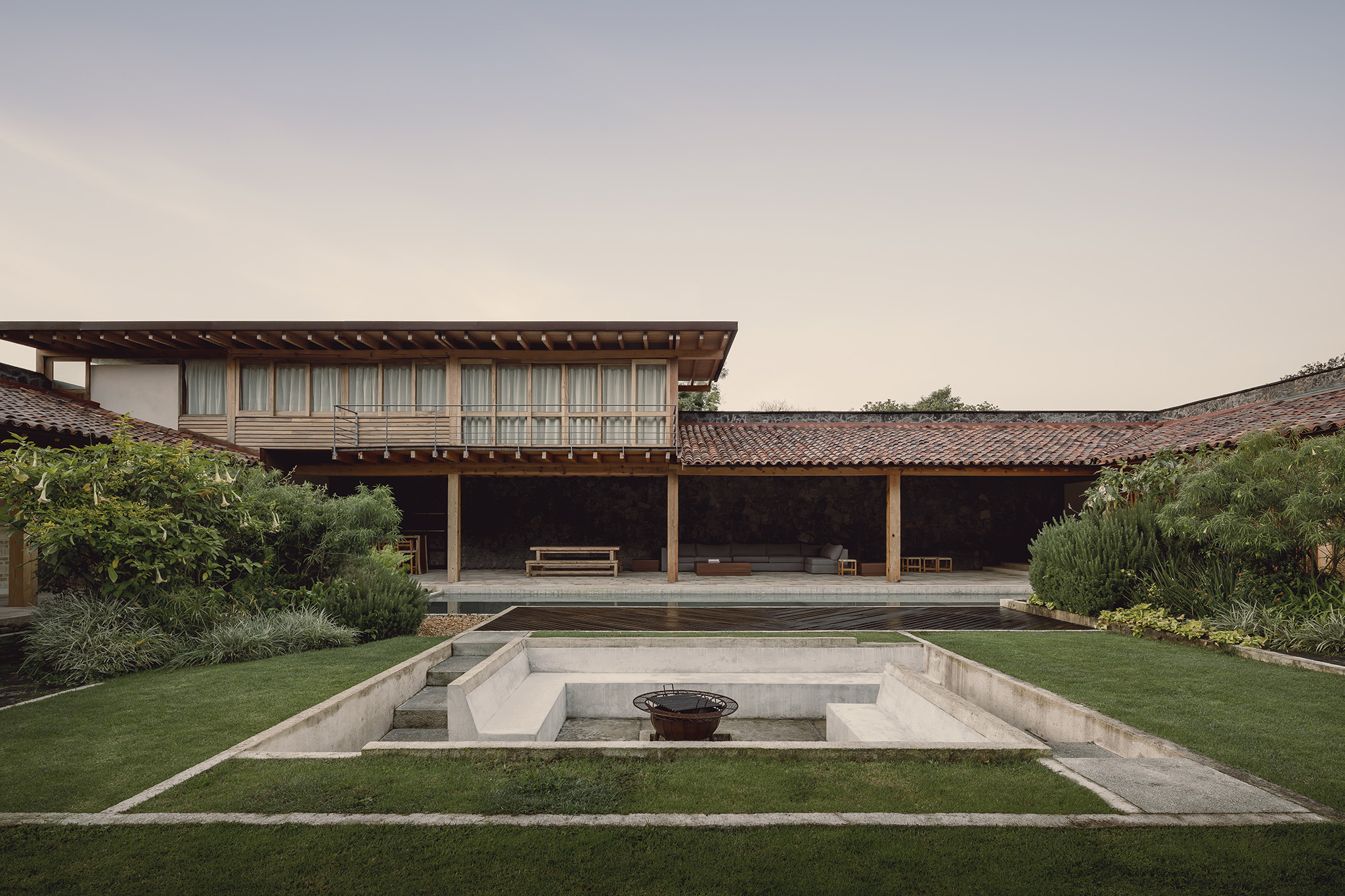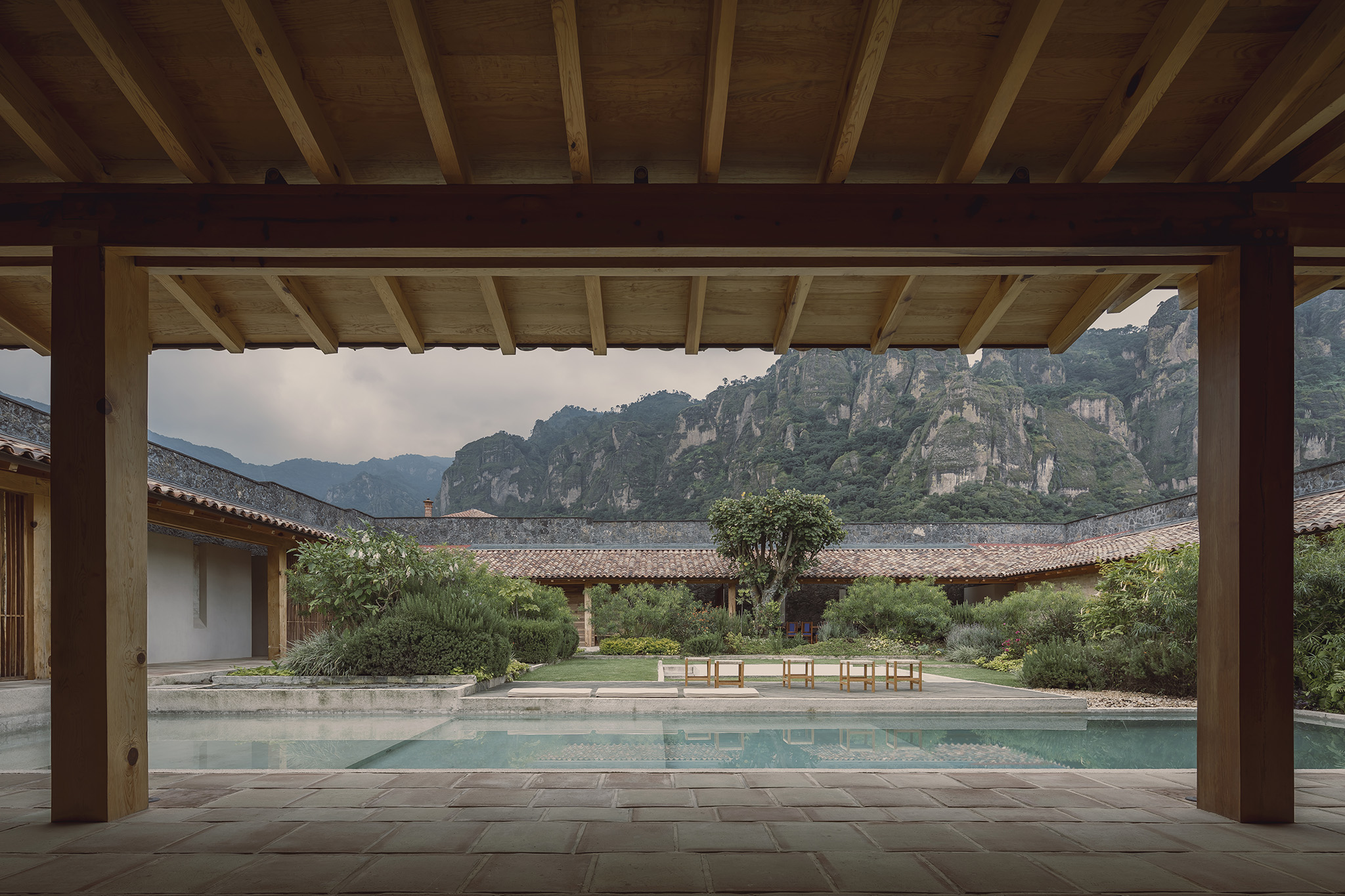Nothing is left outside and all life takes place in the interior world of the house.
The materials dialogue with the place, the land, the climate, and the landscape. The texcal volcanic stone provides structure and gives meaning to all built spaces, rooting them in the territory. Duranguense pine wood is used for the structure of the project and becomes the main material in the interior where it is accompanied by huanacaxtle wood in the lattices and finishes. The rest of the materials form a palette of elements linked to tradition and intelligently raised from a contemporary perspective.
La Hacienda offers a classic Mexican space, reinterpreted in a modern role that combines function with form in a contextual dialogue.

La Hacienda Jardín by Práctica Arquitectura. Photograph by César Béjar, Oscar Hernández.

La Hacienda Jardín by Práctica Arquitectura. Photograph by César Béjar, Oscar Hernández.
Project description by Práctica Arquitectura
Just one hour south of Mexico City, the town of Tepoztlán is located within a valley with a pleasant temperate climate and made up of three rock formations; one of them known as El Tepozteco. In these geographic and climatic conditions, the vegetation is constant and abundant in all its scales; facilitating the diversity of flora, having mountain and subtropical species in the same place. With a population of just over 35,000 inhabitants, it is a quiet place where people seek to escape from the city on weekends or to find a place to retire.
The Hacienda Jardín reflects on the typology of the rest house and the specificities it requires in a given context through the reinterpretation of the concept of the hacienda. Eventually, this house will be transformed into a retirement home so that the programmatic borders that are generated in the perimeter through staple-shaped walls are blurred, allowing the inhabitants to periodically modify the space according to the number of occupants and needs.
The architectural program questions the predominant condition in the area of having to fence the property and then insert a building into it and landscape the rest. The project does the opposite, it becomes a roofed fence open to the weather that contains a garden of endemic vegetation in its center. In this sense, the project starts from opposition to this set of proposals to retake the elements of the town and its environment. In this way, the large patio becomes the diaphragm that regulates interactions, deconstructing the hermetic division between public and private spaces. The roof in the courtyard frames the Tepozteco mountain with which users can maintain an intimate relationship with their environment from anywhere.
Consisting of these two coordinating elements, the central courtyard, and the peripheral volume, the design manifests the persistent connection between the two. The distribution in the perimeter fence and the definition of the scheme in the plan display the walls in the form of staples and lattices that produce plays of light and shadow. Its disconnection from the ceiling provides a sensation of lightness, generating a homogeneous internal bath of light through pergolas. Internal pathways evoke various sensory experiences depending on the direction chosen for them.
The materials create a direct dialogue with the place, the land, the climate, and the landscape. The perimeter wall of texcal volcanic stone contains and shelters all the built spaces. Duranguense pine wood appears as the main structure of the project and becomes the leading material inside through beams and purlins; huanacaxtle wood appears in the lattices and finishes. The terracotta tile floors, the tiled roof, and the brick and chukum walls create a color palette that is sensitive to the specific use of each area.
Finally, there are active and passive solutions to sustainability issues. On the one hand, electrical systems with solar panels and heaters, drainage with a controlled septic tank, irrigation with water collection systems, and natural absorption wells were introduced; On the other hand, the entrance and control of light and natural ventilation were managed in all spaces, while the vegetation helps maintain a stable internal environment, promoting a pleasant microclimate.
La Hacienda offers a classic Mexican space, reinterpreted in a modern role that combines function with form in a contextual dialogue. The house manifests the position it has towards living through its landscapes, distribution, materials, programmatic borders, and typology.































































